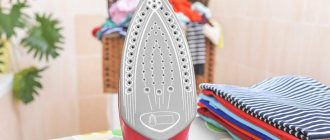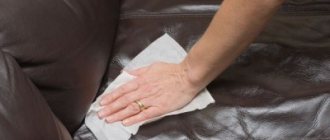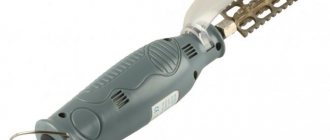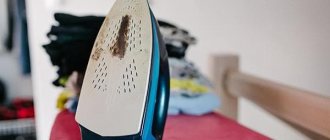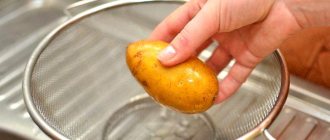4.8 / 5 ( 29 votes)
No matter how great the iron is, it still needs care, incl. in regular cleaning of the soles. This is where soot often forms. It can damage clothes and negatively affect the quality of the iron itself. But don’t panic and immediately think about buying a new device, because we’ll now tell you how to easily get rid of carbon deposits. We have prepared the best selection of recipes that will help you effectively clean the soleplate of your iron .
Outsole material
What types of iron soles are there?
First, let's talk about what material the sole of your iron can be made from. It depends on the material which recipes you can use to clean the soleplate of your iron at home. And which ones cannot be used, because... they may damage the device.
Manufacturers choose the following materials:
- Aluminum . Perhaps one of the most popular materials, because... it belongs to the budget category. Aluminum also conducts heat well, is lightweight, but cannot be said to be durable and reliable. For example, an aluminum sole can leave a hole in a T-shirt if the temperature is not adjusted correctly. And you can’t iron the wool at all.
- Stainless steel . The iron will cost more, but its quality will be better. The sole heats up evenly, which minimizes the possibility of damaging the fabric. Stainless steel is durable and resistant to rust and damage. Therefore, you can safely choose even rough cleaning of the iron to remove burnt marks on the sole.
- Ceramics . It glides easily, removes wrinkles well and heats up evenly. Also, threads and fibers do not collect on the sole, and there are no puffs left on clothes.
- Teflon . A good iron for delicate items. But you also need to handle it carefully, because... Scratches may appear on the surface, and Teflon itself wears off faster than other materials.
All the recipes that we will discuss below are suitable for cleaning the ceramic soleplate of an iron. But to clean the soleplate of a Teflon-coated iron, pay attention to only two methods:
- Pencil.
- Vinegar 70%.
Pros and cons of salt cleaning
Salt is popular as a cleaning agent for a reason. It has important advantages, namely:
- abrasive properties - small grains quickly and effectively remove a layer of soot from the sole of the device;
- the ability to absorb dirt - the product not only removes carbon deposits, but also absorbs it;
- cleanliness and safety - you can work with the food additive without complex precautions, it does not harm your hands and does not emit toxic fumes;
- accessibility - the cleaning product is always available in the kitchen, and if it runs out, you can buy it inexpensively in any store;
- ease of use - the powder does not need to be prepared for use for a long time; all cleaning mixtures are created very quickly.
Attention! Even if salt residue gets on your clothes during ironing, they can be easily removed with water.
Despite all the advantages, the substance has one major drawback. Due to its abrasive properties, it can damage the sensitive coating when cleaning a household appliance. In its dry form, it is not commonly used for Teflon irons, and even with metal and ceramic platforms, care must be taken. Pressing the unit too hard on the powder will result in defects appearing on the coating.
Recipe 1: Clean the soleplate of the iron with salt
How to clean the soleplate of an iron with salt?
Ingredients:
- Salt.
- A blank sheet of paper or cardboard.
How to clean the soleplate of your iron with salt:
- Spread the salt in one layer on a clean sheet of paper or cardboard.
- Split the iron.
- Run the iron over the salt scattered on the sheet, pressing the soleplate firmly. The salt will remove all the carbon deposits from the surface.
Important! Please note that this recipe is not suitable if you need to clean the soleplate of a Teflon iron. Because Coarse salt can scratch it.
How to prevent scale formation
To avoid having to clean scale deposits later, monitor the quality of the liquid you pour into the container. Best for ironing with steam:
- Bottled water, which can be purchased at any grocery store.
- Distilled water. Can be purchased at any gas station.
- Water purified by a home household filter.
- Settled water from the tap. In just a few hours, the salts will precipitate.
Remember that timely prevention will extend the life of electrical appliances. Learn the principles of proper ironing, read the tags on clothes and never leave the appliance turned on unattended. If an emergency occurs, the simple and effective recipes suggested above will help you.
Recipe No. 2. How to clean the soleplate of an iron with vinegar?
How to clean the soleplate of an iron with vinegar?
In any home there is vinegar, which serves as an excellent cleanser, incl. will help you quickly clean the soleplate of your iron.
Ingredients:
- Vinegar.
- Cotton wool, cloth or towel.
- Water.
How to quickly clean the soleplate of your iron with vinegar:
- Option 1 . Soak cotton wool in vinegar and wipe the areas where the burnt marks appear. There is no need to turn on the iron.
- Option 2 . Soak a cloth in vinegar and place a warm, but not turned on, iron on it. Leave the device in this position for several hours. And then wipe dry with a clean cloth.
- Option 3 . Combine 2 tbsp. l. vinegar with a glass of water. Soak a towel in the solution and iron it with an iron operating at medium heat. The best option for large stains.
This recipe is suitable for cleaning the ceramic soleplate of an iron, as well as Teflon, if you use 70% vinegar.
How to remove carbon deposits from an iron with ammonia
Among the many ways to clean an iron from carbon deposits, there is also a method using ammonia. The main advantage of the product is that it can be used to clean any surface. At the same time, medical liquid is considered one of the most effective, capable of removing almost any contaminant.
Cleaning method:
- Moisten a soft rag in ammonia.
- Wipe the cooled platform.
- Using cotton swabs soaked in alcohol, remove the fumes from the holes on the sole.
- Let dry.
Attention! Vapors from ammonia are extremely harmful to the human body, so you need to work with the product in a ventilated area or wearing a medical mask.
Ammonia can be mixed with hydrogen peroxide. Sequence of steps:
- Pour 2 tbsp into a container. l. ammonia.
- Add 1 tbsp. l. peroxide.
- Soak a cotton swab in the resulting mixture.
- Rub the work surface.
- Clean the holes in the sole with a cotton swab.
- Unmute
- Go to website
- Return to view
Important! The iron should be unplugged during the cleaning procedure. At the same time, it should be warm, but not hot.
How to clean an iron from burnt fabric with acetone
Acetone is an aggressive substance that can quickly clean the iron of stuck fabric. But it is not recommended to use it on Teflon coating.
Pollution removal process:
- Moisten a cotton swab with acetone.
- Wipe contaminated areas of the work surface.
- Clean the product with a damp cloth.
Acetone can also be replaced with nail polish remover. If the solution does not contain the above substance, then it can be used for irons with any working surface.
It is also convenient to use white spirit instead of acetone. This product is more aggressive, but can clean even old and heavy carbon deposits. It is important to note that this solvent can damage Teflon and aluminum surfaces. But it can be used on ceramics.
How to clean an iron from burning with citric acid
You can wash the soleplate of the iron from carbon deposits using citric acid. At the same time, the ability of the product to clean delicate surfaces depends on the concentration of the composition.
First way:
- Mix citric acid and water in a container to make a paste.
- Apply the mixture to the base of the appliance using a dish sponge.
- Turn on the iron at maximum power.
- As soon as the mixture smells, turn off the electrical appliance and immediately clean it with a damp sponge.
Attention! Work can only be carried out with cotton gloves, since the sole of the iron is hot and steam is generated during operation.
The second method is suitable for delicate coatings:
- Dilute 1 tbsp in a glass of water. l. citric acid.
- Soak a piece of cloth in the resulting solution.
- Treat the surface of the device (it should be warm).
- Remove residues with a damp sponge.
Third method:
- Sprinkle a few tablespoons of citric acid onto a damp cloth.
- Turn on the iron and heat it to maximum power.
- Iron the material with citric acid.
- Remove any remaining product with a damp cloth.
Important! From time to time, the lemon juicer needs to be replaced with a new one, especially if the ironing device is too dirty. Otherwise, it will not be possible to clean the platform from burnt deposits efficiently.
How to clean the soleplate of an iron from carbon deposits with hydrogen peroxide
Regular hydrogen peroxide, which is found in every first aid kit, will help remove black deposits from the iron. This disinfectant can remove many stains, including burnt fabric. To clean the platform you will need:
- Soak a cotton swab in the liquid.
- Warm up the work surface slightly.
- Treat it with a damp disc.
- Using a cotton swab, remove dirt from the holes on the sole.
If the area with carbon deposits is too large, then you can use a more effective means to tidy up the iron. A composition with peroxide will help clean any burnt-on formation. Sequencing:
- Pour peroxide into a tray or small baking tray.
- Place an electrical appliance in it.
- Wait at least 30 minutes.
- Turn on the device and iron the rag with it to completely clean the platform of burnt deposits.
Important! This method will help clean the iron from carbon deposits inside and outside the soleplate.
Recipe No. 3. How to clean the soleplate of an iron with soda?
How to clean the soleplate of an iron with soda?
Another remedy that you always have at home is baking soda. It will also cope with cleaning the soleplate of the iron from carbon deposits.
What to take:
- Baking soda (plus extra hydrogen peroxide).
- Water.
- Capacity.
How to clean the soleplate of an iron with soda:
- In a container convenient for you, combine baking soda and water, you should get a thick paste.
- Rub the mixture into the sole.
- Then rinse the solution with water and wipe clean.
Second way:
- Heat the iron to the highest possible temperature.
- Soak the sole with peroxide.
- Wait until it cools down.
- Apply a mixture of baking soda and water to the cold sole.
- Wait about 7 minutes. and rinse off the residue, and then wipe the surface with a clean cloth.
Important! We remember that soda is contraindicated for cleaning the soleplate of a Teflon-coated iron.
How to remove carbon deposits from an iron using traditional methods
There are many ways to remove stuck fabric from the iron. It is important to take into account not only what is currently at hand, but also the degree of contamination. For example, salt will quickly and thoroughly clean any carbon deposits, but it cannot be used on delicate surfaces, but paraffin will not harm the sole, but will not cope with serious deposits of burnt fabric.
How to clean an iron from burnt synthetics with salt
Salt acts as an abrasive substance, so it can only be used dry on stainless steel. For more delicate coatings, it is better to use a salt solution with the addition of other components.
The first way to clean the iron from burnt fabric:
- Place a piece of rag on the ironing board.
- Pour 1 tbsp onto the fabric. l. salt (preferably sea salt).
- Turn the iron on at maximum setting, without the steam function.
- Iron the salt, being careful not to press on the appliance.
- Turn off the iron and wipe off any remaining salt with a damp sponge.
- Allow the surface to dry.
- Second cleaning method:
- Sprinkle salt between two layers of fabric.
- Iron on maximum setting without steam.
- Turn off the device and wipe the cooled sole with a soapy sponge.
- Let it dry.
- Third cleaning method:
- Mix a spoonful of salt and 2 drops of detergent in hot water.
- Wet the fabric with the solution.
- Iron it at maximum power.
- Dry.
Important! The latter method is suitable for cleaning burnt fabric on surfaces made of any material.
How to remove carbon deposits from an iron with vinegar
You can clean the surface of the iron from burnt fabric using ordinary vinegar. It can be used alone or mixed with salt, which is more effective.
Cleaning the work platform:
- Place salt and vinegar in equal proportions in a container.
- Heat the mixture until the crystals are completely dissolved.
- Cool the mixture until it is comfortable for use.
- Soak a piece of cloth in it.
- Wipe the work surface.
- Remove the most stubborn burnt-on stains with a brush or sponge.
- Dry the platform with a rag.
- Turn on the electrical appliance and iron a dry piece of cloth, which you won’t mind throwing away later.
Important! The holes on the base of the device must be cleaned with a cotton swab dipped in a vinegar-salt solution.
The use of vinegar can be slightly modified:
- Pour the solution into a small container.
- Boil.
- Place the iron on top so that the entire platform is treated with steam.
- Leave the device until the carbon deposits are completely removed.
Attention! You can add a little baking soda to the vinegar. This solution will quickly soften the burnt fabric and allow you to efficiently clean the dirt.
How to clean a stuck iron with laundry soap
Laundry soap can also effectively clean the iron of carbon deposits and remove burnt-on fabric.
The sequence of actions is as follows:
- Heat the device to maximum temperature.
- Disable steam mode.
- Gently rub the platform with soap.
- After it begins to melt, the carbon deposits will begin to soften.
- After turning off the iron, you need to remove the dirt using a dry rag.
- Then wipe the work surface with a damp sponge and dry.
Important! This method is ideal for Teflon coatings.
There is another method for cleaning soles. You can wipe the iron from carbon deposits with soap crumbs. To do this you need:
- Grind laundry soap.
- Sprinkle it on a piece of cloth.
- Turn on the iron at maximum power.
- Iron the soap.
- Clean the iron on a rag by ironing.
- Repeat the procedure until the dirt is completely removed, alternating between ironing the soap and a clean rag.
To effectively clean the platform with this method, you need to take precautions to avoid allowing melted soap to come into contact with your hands.
How to clean an iron from burning with a candle
You can also wipe off stuck clothes from the iron with a regular candle. In this way, only recent contamination can be removed. Paraffin may not cope with heavy deposits.
Application of the method for cleaning the working surface of the iron:
- Wrap the candle in cotton cloth so that you can hold it without fear of dripping wax.
- Heat the iron by turning it on to maximum setting.
- Draw the resulting pencil along the working surface of the device.
- Important! The iron must be held at a slight angle so that the paraffin can drain, taking with it the burnt scale.
- At the end of the process, you need to wipe the sole with a damp cloth. If grains of wax remain on the iron, the device must be turned on again and the platform must be cleaned with a dry cloth. In order for paraffin particles to be completely removed, you will need to use the steam generation mode.
How to remove burnt marks from an iron with soda
In home life, soda is used in many ways. It can also clean the iron from burnt fibers. Since it acts as an abrasive substance, it cannot be used on all working surfaces of the laundry ironing device. However, metal soles will withstand the effects of dry soda.
- Dissolve 1 tbsp in a glass of warm water. l. soda
- Soak the fabric in the mixture.
- Spread it on the ironing board.
- Iron with a hot iron.
- Remove any remaining soda with a dry cloth.
A more effective method will be one that will rid a smooth surface of heavy carbon deposits. For cleaning you need:
- In a suitable container, mix baking soda with water to form a paste.
- Apply the mixture to the soleplate of the iron using a sponge.
- Grind.
- Remove any remaining powdery substance with a damp cloth.
Attention! To perform the procedure, the iron should be slightly warm, without burning your hands.
If you need to clean the Teflon surface with soda, then you will need to change the composition of the cleaning agent:
- Mix 1 tbsp. l. soda, 1 tbsp. l. starch, 1 tsp. dishwashing gel.
- Bring everything to the consistency of thick sour cream, gradually adding water.
- Apply the mixture to the warm platform of the iron.
- Wipe the surface with a soft cloth.
- Remove residues with a damp cloth.
Important! There should be no undissolved crystals in the mixture.
How to clean carbon deposits on an iron with toothpaste
Toothpaste can also quickly and effectively remove fumes from your iron. It dissolves particles of burnt fabric well, but only if they are fresh. Otherwise, to achieve the desired result, you will have to spend more time and effort on cleaning.
How to remove dirt:
- Heat the iron to maximum.
- Use a sharp object to remove the burnt marks (as far as the degree of contamination allows).
- Apply toothpaste (you can use a brush or sponge).
- When the iron cools, the paste will harden. You will need to slightly moisten the dishwashing sponge and use the hard part to clean the platform of the electrical appliance.
- Wash off any remaining cleaning agent with a rag and allow to dry.
- Toothpaste can be replaced with powder, but in this case it can only be used on metal surfaces.
So that when using the product there are no microcracks and scratches left on the sole of the iron, it must be supplemented with a simple component - glycerin. Sequence of procedure:
- Mix tooth powder and glycerin in equal proportions.
- Heat the composition in a water bath.
- Apply the mixture to the working surface of the electrical appliance.
- Grind a little.
- Remove any remaining product with a damp sponge.
- Dry the platform.
Recipe No. 4. Cleaning the soleplate of the iron with laundry soap
How to clean the soleplate of an iron with laundry soap?
It will help if you decide to clean the ceramic sole of your iron at home, but the carbon deposits on it are not strong.
What to take:
- Laundry soap.
- Warm water.
- Capacity.
- A napkin or cotton swab, cotton swabs.
How to clean the soleplate of an iron with laundry soap:
- Preheat the iron at minimum temperature.
- Rub the surface with a bar of soap.
- Wait until the soap softens the carbon deposits.
- Remove soap residue with a napkin or disk, and treat the steam holes with a cotton swab.
Second way:
- Dissolve crushed pieces of soap in warm water.
- Use a napkin to wipe off the soot as much as possible.
- Apply a soap solution to a dry sole heated at a minimum temperature.
- Wait 20 min.
- Wipe the surface with a clean cloth.
Recipe No. 5. How to clean the soleplate of an iron with toothpaste?
How to clean the soleplate of an iron with toothpaste?
Cleaning the soleplate of your iron with toothpaste is very easy.
What to take:
- I love any toothpaste.
- Brush or soft cloth.
- A napkin.
How to clean the soleplate of your iron with toothpaste:
- Apply the paste from the tube to the contaminated areas of the sole.
- Rub with a toothbrush or cloth until clean.
- Wipe the surface clean with a damp cloth.
This method is best suited if you are thinking about how to clean the soleplate of a ceramic-coated iron.
Sole cleaners with high mechanical strength
This includes irons with titanium, steel (without coating), and composite soles. Such devices can be cleaned with abrasives, but the use of acid-containing products is not recommended, as unsightly dark streaks and stains may remain.
Advice! If the soot is fresh, for example, a thin fabric accidentally melted, or chewing gum stuck and burned, you should try to remove most of the dirt with a wooden spatula or spatula. But if the stain has managed to cool and harden, there is no use picking at it.
The first thing you should use for cleaning is regular fine table salt. It is poured into a baking sheet or onto a cloth in a layer of up to 0.5 cm. And then everything is simple - heat the iron to maximum and move it forcefully over the grains. The carbon deposits are eventually removed mechanically.
Cleaning with salt
To speed up the cleaning process, the salt is pre-mixed with finely grated paraffin.
You can also clean a hot iron with paraffin. The candle is moved along the sole, while the iron is held above a layer of newspapers or an old rag at an angle of 45 degrees. Paraffin melts from contact with a hot surface and flows down along with soot particles.
Paraffin candles
Advice! If the iron has holes for steam to escape or the surface of the sole is embossed, you should not use paraffin. It will clog into the recesses, and during the first use of the iron for its intended purpose, it will leak directly onto the clothes.
Another affordable and effective remedy is regular toothpaste. You can use absolutely any, but mint and whitening are preferable. A little paste (a strip 2-3 cm long) is applied to the hard side of a damp dishwashing sponge and actively cleans the sole.
How to clean the soleplate of an iron with toothpaste
Toothpaste can be mixed with baking soda or salt, or both. The cleaning ability of the mixture will only improve.
Advice! After using any traditional methods, first iron an old or unnecessary item of clothing in case there is some cleaning agent left on the sole.
Another well-known method is to use strips of sulfur from matchboxes. The rough surface of the strips facilitates quick mechanical cleaning of the sole.
It is better to take a new matchbox so that the sulfur strip is intact
The most modern means for cleaning irons is a melamine sponge. The melamine resin foam sponges are soft and have a rubber-like feel. Despite its softness, the sponge is a good abrasive. Small nanoparticles effectively cope not only with carbon deposits, but also with most known contaminants. There is no need to wet the sponge in cleaning agents or detergents.
Melamine sponge
The melamine sponge is lightly moistened with water and wrung out without twisting. Dirty stains are rubbed off with the corner of a sponge, applying light pressure. After cleaning, the surface of the iron is wiped so that no traces of melamine remain, and crumbs from the sponge are swept into the trash.
If a piece of polyethylene sticks to the iron and melts, wash it off with acetone or nail polish remover, being careful not to touch the plastic parts of the iron.
Acetone
And very small stains can be removed with a soap-ammonia solution. Add ammonia and 1 teaspoon of dishwashing detergent or liquid soap to half a glass of water, mix, foam with a sponge and treat the surface of the sole, then iron with an old woolen rag. The procedure is repeated several times until the iron becomes clean and shiny.
Soap-ammonia solution
Recipe No. 6. Cleaning the soleplate of the iron with a pencil
How to clean the soleplate of an iron with a pencil?
You can buy a pencil at a hardware store. But before you clean the soleplate of the iron with a pencil, read the instructions that come with it. It is also better to carry out the procedure in a ventilated area, because... Substances contained in the pencil may evaporate and produce harmful smoke.
What to take:
- Pencil.
- Soft napkins or cloth.
How to clean:
- Preheat the iron to the temperature specified in the instructions for the pencil.
- Use a pencil to work on the problem areas on the sole. But do not press too hard so that it does not crumble under your fingers. Otherwise, pieces of pencil may get into the steam holes and the operation of the iron will be disrupted.
- The pencil will melt under the influence of temperature.
- Use a soft cloth or rag to remove any remaining dirt, and after the iron has cooled down, wipe the surface with a dry and then a wet cloth.
Suitable for cleaning the soleplate of an iron with any coating: ceramics, metal, Teflon.
What can be used for different types of surfaces
Before cleaning the iron from plaque, you need to carefully examine the surface: find out what material it is made of. Information about the soleplate can be found in the instructions for the electrical appliance. It is necessary to inspect the surface for scratches and dirt. Information about the material of the sole is important, since ceramic can be cleaned in one way, and Teflon in a completely different way.
Modern irons are covered with different materials and equipped with holes for steam. Any method of cleaning up pollution is unacceptable to them. These old, Soviet types of irons could endure tests and experiments on cleaning the surface using various detergents and cleaning agents. The Soviet iron is the most durable, but it is a rarity. It is worth starting from modern realities and understanding that it is already a thing of the past, and now they sell irons with more delicate coatings.
There are the following types of irons:
- With aluminum surface. It quickly becomes unusable, a lot of scratches appear on it, which means it gets dirty faster. Its advantages are that it has high thermal conductivity and heats up quickly. You can’t clean with cheap products, it’s better to use only a pencil.
- Stainless steel surface. With such an iron you need to iron it carefully, through gauze. Can be cleaned more often than aluminum. Stainless steel material resists scratches and chips.
- Ceramic or metal-ceramic coating. Customers like these irons, they provide comfortable ironing and are cheap. However, they require some maintenance during operation. Ceramic metal is fragile, although the material is stronger than Teflon. It is better to clean it not with bulk products, but with liquid products containing acid. Any scratch can cause the ceramic coating to peel off.
- Glass ceramics, Teflon, titanium. These coatings provide easy and comfortable ironing, but require careful use. They rarely leave marks on the fabric, and cauterization almost never occurs. A pencil is suitable for cleaning products, since any product can harm and damage an electrical appliance. By damaging the thin Teflon coating, you can get to the metal and then rust will likely appear. This coating requires special cleaning; special sponges are designed for it.
Recipe No. 7. Cleaning the soleplate of the iron with a candle
How to clean the soleplate of an iron with a candle?
An analogue of a pencil for quickly cleaning the soleplate of an iron at home is the usual paraffin candle. But it can handle light stains.
What to take:
- A candle.
- Fabric or paper.
- A napkin.
How to clean the soleplate of an iron with a candle:
- Heat the iron to a high temperature, but you will have to select it experimentally.
- Wrap the edge of the candle that you hold in your hand in cloth or paper.
- Apply the candle to the surface of the iron, but hold it at an angle to prevent wax from getting into the holes.
- Let the device cool down.
- Remove any remaining wax and dirt with a napkin.
Recipe No. 8. Cleaning the soleplate of the iron with hydrogen peroxide and ammonia
How to clean the soleplate of an iron with ammonia and hydrogen peroxide?
What else can you use to clean the soleplate of your iron? Peroxide and ammonia!
What to take:
- Hydrogen peroxide.
- Ammonia.
- Water.
- Capacity.
- Textile.
How to clean the soleplate of an iron with hydrogen peroxide and ammonia:
- Mix five drops of ammonia and half a glass of water in a container.
- Wipe the base of the device with the solution.
- Dry with a cloth.
Recipe No. 9. How to clean the soleplate of an iron with solvent?
How to clean the soleplate of an iron with solvent?
This recipe will help not only clean the iron from burnt soles, but also get rid of delicate fabric, polyethylene, etc. stuck to the surface.
What to take:
- Nail polish remover or B-47.
- A cotton pad or fabric made of natural material.
How to clean the soleplate of an iron with solvent:
- Dampen the disc or cloth with solvent.
- Wipe the cold soleplate of the iron.
- Remove any residue with warm water and wipe the surface dry.
Important! During the procedure, the surface of the iron should be cold.
Removing scale from inside
Almost all irons now come with steam - they are more convenient and efficient. During operation, scale forms inside - these are insoluble substances that water contains. They exist if undistilled water is poured into the iron. If the iron has a self-cleaning function, turn it on periodically. If not, you will have to act differently.
This is what was inside the steam iron
Cleaning from the inside
To remove scale from the iron, you need to pour acidified water inside. Scale is salts; an acidic environment corrodes them, they loosen and come out with steam. It is better to take water that is as purified as possible. Better - distilled. If it is not available, it can be boiled or after a good cleaning. Add citric acid to the water. For 200 ml - about 25 grams, per liter - 5-6 tablespoons. You can also add alcohol vinegar (one glass of 9% per liter), but it has a more unpleasant odor.
In order to clean the inside of the iron, you need to fill it with water and citric acid and turn it on until it heats up. And this is what comes out of there
Pour acidified water into the iron reservoir. In terms of quantity - to the maximum. Turn on the iron to maximum temperature. Heat until the light goes out twice or three times. Turn off the iron and go to the sink. We give him a good shake and let off some steam. If it has cooled down and there is still water inside, heat it up again, turn it off and continue cleaning.
The final stage is to pour in clean water and “evaporate” all of it. You can do this over an old impression rag. Usually, after observing what has accumulated inside, they forget to clean the iron less often.
Boiling
The same composition (water with vinegar or citric acid) is poured into a baking tray with high sides. We put two chopsticks on the bottom (you can use them for sushi, you can just use wood chips). The purpose of the sticks is to provide a gap between the baking sheet and the soleplate of the iron.
We place the cold iron in a container on some pieces of wood. The liquid level should be such that it covers the sole, but does not reach the plastic parts. We put all this on the burner, bring to a boil, and leave to cool. Heat again, cool. So 2-4 times. Next, you need to drain the water that got inside the iron through the steam holes. You can drain it through the filler hole. The water will not be clean, usually yellow with scale residues.
Don’t know how to clean the inside of your iron from scale? Water with citric acid
Pour clean water into the iron, rinse and pour out. Then you need to leave it alone until it dries. After a couple of hours, you can turn it on and try ironing.
Prevention and care tips
Tips for keeping the soleplate of your iron clean
To avoid cleaning your iron so often from carbon deposits on the soleplate, follow these preventative measures and listen to these tips:
- If you suddenly make a hole in the fabric and it sticks to the sole, apply cotton soaked in cold water to this place. This will help peel the fabric away from the sole.
- When cleaning, do not use rough brushes, sponges, napkins, etc. Especially when it comes to ceramics or Teflon.
- Avoid abrasive cleaners.
- Do not leave water in the iron after ironing; drain it into the sink.
- Use clean water, not tap water.
How to prevent dirt from appearing on the soles
It is easier to prevent contamination from appearing on the device than to deal with it.
- Maintain proper temperature conditions. For silk, 110 degrees is enough, for cotton items - 200 degrees, and for wool - no more than 140. Many do not pay due attention to this rule, and this can affect the condition of the items and the iron.
- Make it a rule to turn off the electrical appliance immediately after finishing work.
- To avoid having to clean the surface from plaque, after every 3-4 ironing, wipe the sole with a cloth soaked in citric acid diluted with water.
- If the surface is clean, but still does not slip, you can correct the situation with the help of paraffin. Grate it, mix it with salt and pour everything into the newspaper. Cover with a thin napkin and iron with a hot iron. If necessary, the manipulation is repeated, because this method does not harm the material.
